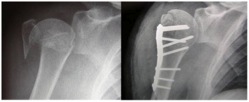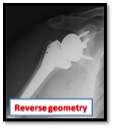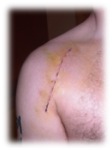Humerus Fracture @ Shoulder
Proximal humeral fracture
This is a common fracture that occurs after direct trauma followig a fall. It is more common in osteoporotic bone which occurs as you get older. Severe pain, swelling and an inability to move the arm are the typical signs and symptoms of a broken shoulder.Non operative treatments
Many proximal humeral fractures do not require surgery because the broken pieces of bone are in a good position (undisplaced) and are not likely to move (stable), so surgical fixation is not required. Even when the fracture fragments have moved it is not always necessary to fix them back into place because the shoulder can compensate very well. A support sling followed by early physiotherapy will result in good pain free movement. It takes 2 weeks for the pain to settle and sleeping can be difficult. After this time the pain improves and by 6-8 weeks the bone will have mended. It is important to take regular pain killers and follow the rehabilitation program set out by your physiotherapist.Operative treatments
Fractures which are badly displaced or have broken
into the joint surface may require reconstruction.
require reconstruction.
If the bones are allowed to heal with a step in the articular cartilage they will become painful and stiff which will result in poor function. The decision to operate will depend on the way the bone has broken, the quality of the bone, the needs of the patient and the expertise of the surgeon. Our most common operation for this type of fracture is the locking plate. Through a 10-15cm incision the bone pieces are put back together and held with a plate and some screws. This is special plate which locks the screws in place and has revolutionised the treatment of osteoporotic fractures.
 If the shoulder fragments are too badly broken or crumbled away; a joint replacement is an option. This may be necessary when the screws cannot hold the broken pieces together because they are too small, the bone has been crushed or the articular surface of the humeral head is split. (see video Total shoulder replacement)
If the shoulder fragments are too badly broken or crumbled away; a joint replacement is an option. This may be necessary when the screws cannot hold the broken pieces together because they are too small, the bone has been crushed or the articular surface of the humeral head is split. (see video Total shoulder replacement)
In some patients the tendons of the rotator cuff are damaged; if this is the case a reverse geometry shoulder replacement can restore excellent function in what would otherwise be a useless, painful shoulder. (see shoulder arthritis)
What should I expect after the operation?
The anaesthetist will have used an anaesthetic block to make the arm numb during surgery and the immediate post operative period. Once the numbness has worn off (4-8 hours) the shoulder will become painful and you will be given regular pain killers as soon as you get back to the ward. Even though you may be pain free at rest you must take the tablets for when you move the shoulder as part of your rehabilitation program. A combination of regular painkillers such as paracetamol or codeine should be taken with NSAIDs (unless contra-indicated) such as ibuprofen- which is also an anti inflammatory drug. If the pain killers you have been given are not sufficient please contact your consultants secretary or your GP.
numb during surgery and the immediate post operative period. Once the numbness has worn off (4-8 hours) the shoulder will become painful and you will be given regular pain killers as soon as you get back to the ward. Even though you may be pain free at rest you must take the tablets for when you move the shoulder as part of your rehabilitation program. A combination of regular painkillers such as paracetamol or codeine should be taken with NSAIDs (unless contra-indicated) such as ibuprofen- which is also an anti inflammatory drug. If the pain killers you have been given are not sufficient please contact your consultants secretary or your GP. Both plating and joint replacement are carried out through a 12- 20 cm incision which is closed with a dissolving stitch. This heals well, usually leaving a faint scar. The dressing should remain on for 10- 14 days, kept clean and dry until it is removed at your follow up appointment. If you have any concerns about the wound you should contact your surgeons secretary or your GP practice nurse.
You will be given a sling which will protect your shoulder and should be worn for a minimum of 3 weeks. You will need a dedicated physiotherapy program after your surgery. If you have been seeing a physiotherapist prior to your surgery (who may have referred you to Guildford Upper Limb), you should arrange to see them afterwards so you can start your rehabilitation straight away. If you do not have a physiotherapist we can arrange one for you.
Is there anything that can go wrong? Operations to fix fractures are very successful and most people who have them are delighted with the operation and are glad they had it done. Like any operation a very small number of people can have a problem. The main problems with fracture fixation are infection, bleeding and loosening of the plate and screws. Nerves can be bruised and the shoulder can become stiff (see frozen shoulder). The risks of these problems only add up to 2-3% of all operations but need to be taken into account when deciding whether to have the operation. You should discuss the possibility of problems with your surgeon before your operation.



